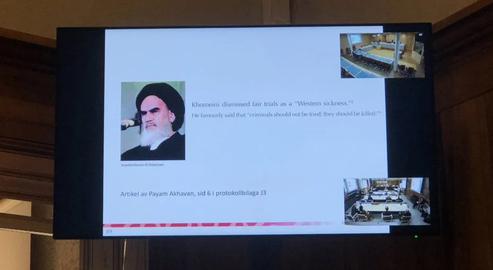On the second day of the criminal trial of ex-Iranian prison official Hamid Nouri in Sweden, prosecutors painted a harrowing picture of how thousands of people were systematically sent to their deaths in the summer of 1988.
Arrested in November 2019, Nouri is on trial for war crimes and murder over his alleged part in the 1988 massacre of political prisoners on the orders of Ayatollah Khomeini in the aftermath of the Iran-Iraq war.
On Wednesday, August 11, lawyers at Stockholm District Court presented a detailed map of Gohardasht Prison in Karaj, near Tehran, where Nouri then worked as a prosecutor’s assistant. They described how jailed opposition members were taken for brief interrogations, one at a time, in the prison’s amphitheater in front of the infamous Tehran “death panel”.
The prisoners, they said, were made to “confess” in front of a camera thought to have belonged to state-owned TV channels. Those found to have not given up their political allegiances were immediately taken away and hanged. Eventually a gallows was erected in the same hall.
Survivors and former detainees, presented to the court as plaintiffs, also described the inhumane conditions of Gohardasht Prison and the torture they and other like-minded inmates had been subjected to.
During the hearing on Wednesday, Swedish prosecutors named those thought to have played a key role either on the Tehran “death panel” or in implementing its orders. They included Ebrahim Raisi, Mostafa Pourmohammadi, Hossein-Ali Nayeri, Esmail Shushtari, Morteza Eshraghi, Judge Mohammad Moghiseh (aka Naserian) and Hamid Nouri (aka Abbasi).
Court Session Halted by Noisy Protests
Large numbers of victims’ families, Iranians living abroad and members of diverse political groups opposed to the Islamic Republic gathered in front of the courthouse during the proceedings. Some held banners aloft and chanted slogans against the Islamic Republic and its leaders.
"I am Iranian," Hamid Nouri told the presiding judge over the noise of the protests outside. “I can hear the chants. This is a kind of torture for me."
So loud did the demonstrations become that the judge ordered a 15-minute break and had to ask those outside to be quiet while the court was in session.
Defense Counsel: Mass Murders 'Not a War Crime'
Defense lawyers for Hamid Nouri told the court their client denied all charges against him, arguing on a technicality that under the Geneva Convention the mass slaughter could not be considered a war crime.
They also claimed that the infamous fatwa from Ayatollah Khomeini that gave the green-light for the killings take place – understood to have been dictated to his son Ahmad on or around July 28, 1988 – was incorrect. Prosecutors referred the court to the published memoirs of Grand Ayatollah Hussein-Ali Montazeri, a leader of the Islamic Revolution and close ally of Khomeini, as evidence that such an order had indeed been made.
“It is decreed,” Khomeini had reportedly decreed in 1988, “that those in prisons throughout the country who remain steadfast in their support for the Monafeqin [“hypocrites”, a term he used for opposition group the MEK] are considered to be mohareb [waging war on God] and are condemned to execution.”
Prosecutors also noted a point made by international lawyer Payam Akhavan in a research article, in which he noted the then-Supreme Leader believed: “Criminals should not be tried. They should be killed.”
Nouri’s lawyers had also previously claimed his arrest at Stockholm Airport in November 2019 was a case of mistaken identity. On Wednesday, prosecutors at Stockholm District Court examined the defendant’s mobile phone records and displayed text messages in which he introduced himself as both “Hamid Abbasi”, the pseudonym he used in Gohardasht in 1988, and “Hamid Nouri”.
The case continues.
Related coverage:
Hamid Nouri's Trial: Where Is Siamak Toubaei?
Hamid Nouri Trial Opens in Stockholm
'The Nation is a Plaintiff': Scores of Iranians to Testify in Case Against Hamid Nouri
Hamid Nouri to Face Trial for War Crimes in Sweden Over 1988 Massacre of Iranian Prisoners
Iranian Ex-Prisoners Recall 'Courier of Death' Hamid Nouri Ahead of Sweden Trial
Justice at Last? 1988 Massacre Suspect Arrested in Sweden
A Move For Justice Around the World
Raisi's Crimes Against Humanity Will Haunt his Presidency
visit the accountability section
In this section of Iran Wire, you can contact the officials and launch your campaign for various problems

























comments